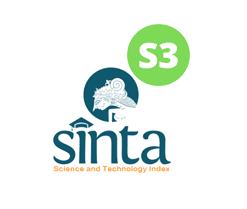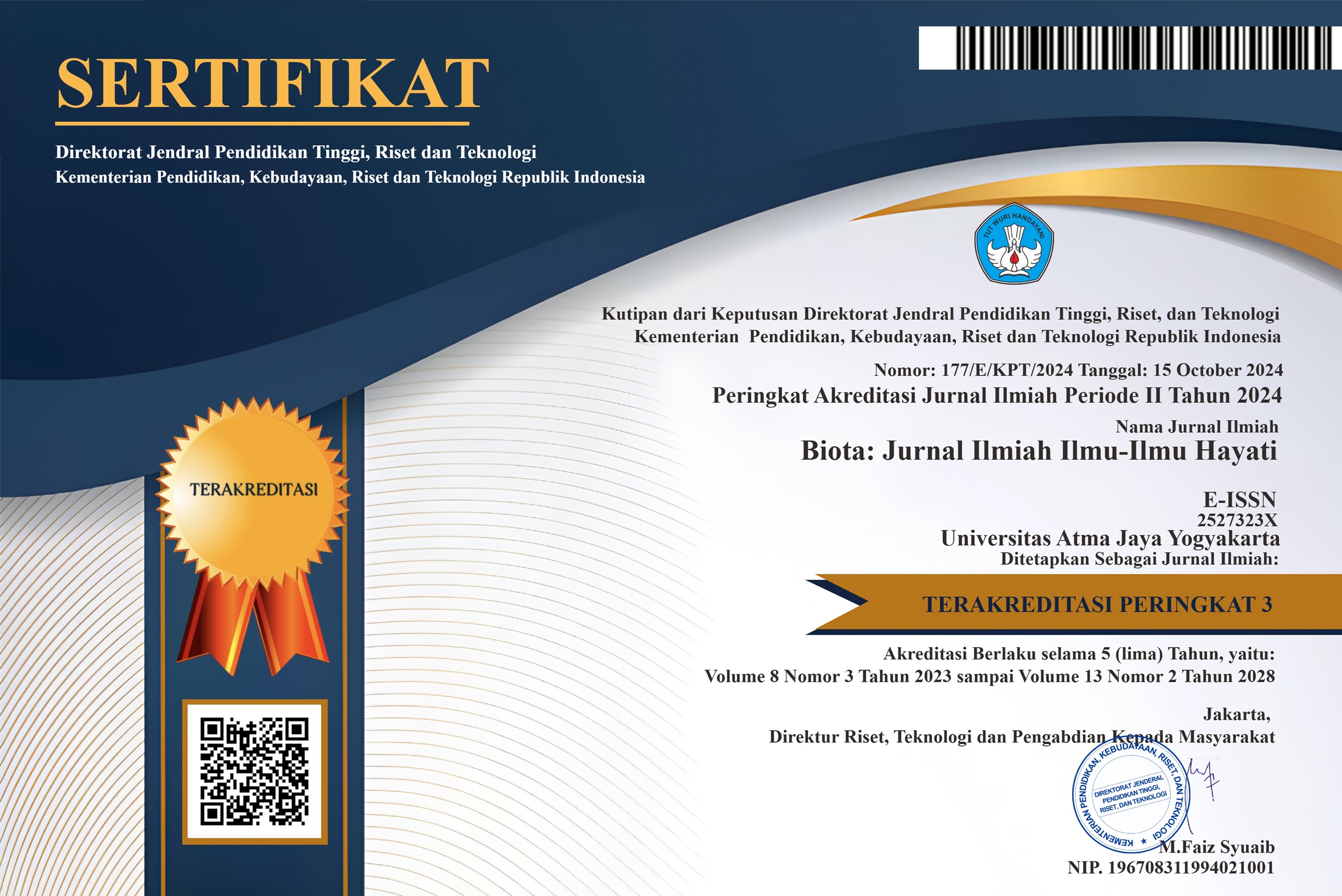Karakterisasi Kandungan Fitokimia Estrak Daun Karamunting (Melastoma malabatchricum L.) Menggunakan Metode Gas Chromatography Mass Spectrometry (GC-MS)
DOI:
https://doi.org/10.24002/biota.v4i1.2363Keywords:
Melastoma malabathricum L., Phytochemical, gas chromatography mass spectrometry (GC-MS)Abstract
Melastoma malabatchricum L. is a type of plant that is widely grown in South and Southeast Asia, including Indonesia and it has benefits as a medicinal plant. In Kalimantan, Karamunting leaves is used to treat wounds, fever, diarrhea, and tannins in its root is used to darken teeth or eyebrows. The usage standard of this plant as an herbal medicine is still based on people's habits, so research needs to be done to find out how much phytochemical content is found in M. malabatchricum L. The priorknowledge of phytochemical M. malabatchricum L. becomes the basis for developing its potential as a plant medicine and its use in various fields. This research was conducted at the Agriculture Faculty Agrotechnology Laboratory, UBT. The research consisted of characterization of Karamunting plants, leaf extraction by maceration, and phytochemical content analysis with GCMS. The results showed that M. malabatchricum leaf extract contained phenol compounds of 36.32%, fatty acids (20.74%), terpenoids (9.13%), sterols (5.77%), alkaloids (4.8%), amino acids (3.5%), aldehyde (3.15%), alcohol (1.54%) and several other compounds. Some types of compounds found are known to have potential as antibacterial, antiviral, antioxidant, cytotoxic, anticoagulant, wound healing, antidiareous, antivenom and anti-inflammatory.References
Begum, D. and. Nath, S.C. 2000. “Ethnobotanical reviewof medicinal plants used for skin diseases and related problems in Northeastern India,” Journal of Herbs., Spices and Medicinal Plants, 7: 55-93. Bharadwaj, S. and Gakhar, S.K. 2005. “Ethnomedicinal plants used by tribals of Mizorum to use cuts and wounds,’ Indian Journal of Traditional Knowledge, 4:75-80. Blomhoff, R. 2010. Role of Dietary Phytochemicals in Oxidative Stress. Oslo: The Norwegian Academy of Science and Letters. Proceedings from a Symposium. Brielmann, H.L., Setzer, W.N., Kaufman, P.B., Kirakosyan, A. and Cseke, L.J. 2006. Phytochemicals: the chemical components of plants, p.1-49. In L.J. Cseke, A. Kirakosyan, P.B. Kaufman, S.L. Warber, J.A. Duke and H.L. Brielmann (Eds.). Natural Products From Plants. CRC Press: New York.
Departemen Kesehatan Republik Indonesia. 2008. Farmakope Herbal Indonesia (Edisi I). Jakarta: Departemen Kesehatan Republik Indonesia. De Roos N.M., Bots M.L., dan Katan M.B. 2001. Replacement of dietary saturated fatty-acid and stearic acid by trans fatty acids lower serum HDL cholesterol and impairs endothelial function in healthy men and women. Arterioscler Thromb Vasc Biol, 21 (7): 1233-7. Gabay, O., Sanchez, C., Salvat, C., Chevy, F., Breton, M., Nourissat, G., Wolf, C., Jacquest, C., and Berenbaum, F. 2010. Stigmasterol: a phytosterol with potential anti-osteoarthritic properties. Osteoarthritis and Cartilage, 18:106-116 Gopalakrishnan, S. 2011. GC-MS analysis of some bioactive constituents of Mussaenda frondosa Linn. Intl. J. Pharma. and Bio. Sci, 2(1):313320. Grubben, G.H.J., Siemonsma, J.S. and Piluek, K. 1994. An Introduction, p.17-54. In J.S. Siemonsma and K. Piluek (Eds.). Vegetables: Plant Resources of South-East Asia 8. Prosea Foundation:Bogor. Harborne, J.B. 1987. Metode Fitokimia Penuntun Cara Modern Menganalisis Tumbuhan: ITB. Bandung. Heyne, K. 1987. Tumbuhan Berguna Indonesia. Jilid I dan II. Terj. Badan Libang Kehutanan. Cetakan I: Koperasi karyawan Departemen Kehutanan Jakarta Pusat. Hugh Tan, T.W. and Yeo, C.K. 2009. “The Potential of Native Woody Plants for Enhancing the Urban Waterways and Waterbodies Environment in Singapore,” Raffles Museum of Biodiversity Research and Singapore-Delft Water Alliance, National University Singapore, Singapore. p. 14, Jananie, R.K., Priya, V. and Vijayalakshmi, K. 2011. Determination of bioactive components of cynodon dactylon by GC-MS analysis. New York Sci. J, 4(4):16-20. Koay, S.S. 2008. “Establishment of cell suspension culture of Melastoma malabathricum L. for the production of anthocyanin,” PhD. Thesis, Universiti Sains Malaysia, Pulau Pinang, Malaysia, Kris-Etherton, P.M., Hecker, K.D., Bonanome, A., Coval S.M., Binkoski, A.E., Hilpert, K.F., Griel, A.E. and Etherton, T.D. 2002. Bioactive compounds in foods: their role in the prevention of cardiovascular disease and cancer. Am. J. Med, 113 (9):71-88.
Downloads
Published
How to Cite
Issue
Section
License
Copyright (c) 2019 Kartina,Mohammad Wahyu Agang , Muhammad Adiwena

This work is licensed under a Creative Commons Attribution-NonCommercial 4.0 International License.
Authors who publish with Biota : Jurnal Ilmiah Ilmu-Ilmu Hayati agree to the following terms:
- Authors retain copyright and grant the Biota : Jurnal Ilmiah Ilmu-Ilmu Hayati right of first publication. Licensed under a Creative Commons Attribution-NonCommercial 4.0 International License that allows others to share the work with an acknowledgment of the work's authorship and initial publication in this journal.
- Authors are able to enter into separate, additional contractual arrangements for the non-exclusive distribution of the journal's published version of the work (e.g., post it to an institutional repository or publish it in a book), with an acknowledgment of its initial publication in Biota : Jurnal Ilmiah Ilmu-Ilmu Hayati, and as long as Author is not used for commercial purposes.













